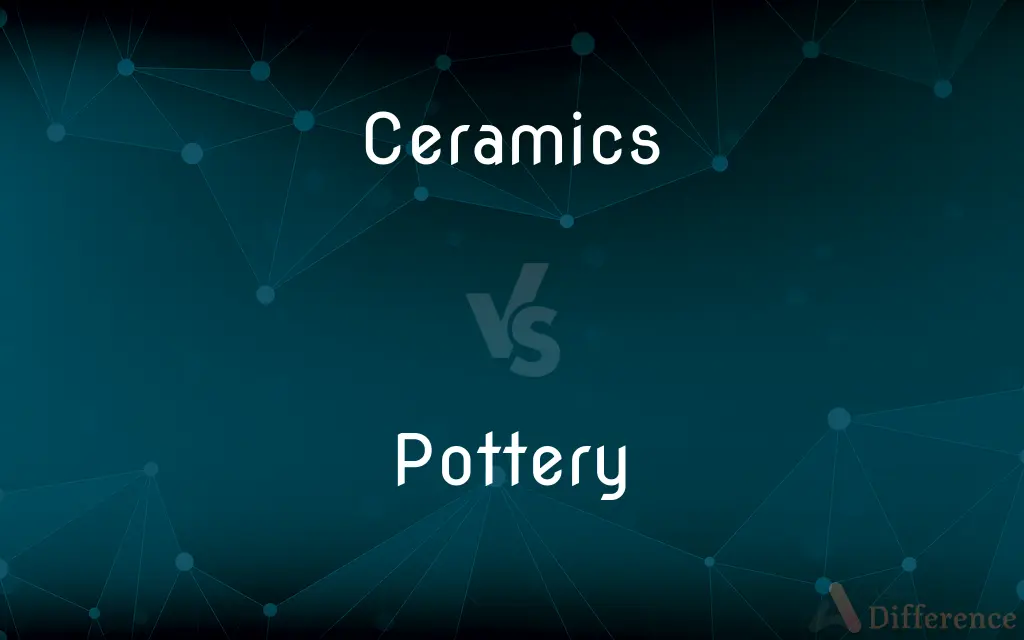Ceramics vs. Pottery — What's the Difference?
Edited by Tayyaba Rehman — By Urooj Arif — Updated on April 27, 2024
Ceramics encompasses a wide range of inorganic, non-metallic materials hardened by heat, while pottery specifically refers to objects made from clay and hardened by heat.

Difference Between Ceramics and Pottery
Table of Contents
ADVERTISEMENT
Key Differences
Ceramics include various hard, brittle materials made by firing non-metallic minerals at high temperatures. Whereas, pottery is a type of ceramic specifically made from clay that has been shaped and then hardened by heating.
Ceramics are used for a variety of applications, including industrial components like insulators and abrasives, due to their diverse properties. On the other hand, pottery tends to be associated with artistic and functional items such as vases, dishes, and other household objects.
The process of making ceramics can involve different materials such as alumina, silicon carbide, and porcelain. While, pottery primarily uses natural clay and sometimes mixes it with other materials to enhance characteristics like strength and color.
Ceramics are often valued for their mechanical and thermal properties, making them suitable for extreme environments. Whereas, pottery is often appreciated for its aesthetic qualities and its cultural significance across various civilizations.
Technological advancements have led to the development of advanced ceramics with superior properties for specific applications. On the other hand, traditional pottery techniques continue to be practiced and valued for their cultural heritage and artistry.
ADVERTISEMENT
Comparison Chart
Definition
Inorganic, non-metallic materials hardened by heat.
Objects made from clay and hardened by heat.
Materials Used
Clay, alumina, silicon carbide, zirconia.
Primarily natural clays, sometimes mixed with other substances.
Primary Use
Industrial, technological, and artistic.
Artistic and functional household items.
Properties
Hard, durable, often heat-resistant.
Aesthetic, heat-resistant, generally less durable than some ceramics.
Example of Use
Electrical insulators, space shuttle tiles.
Vases, bowls, plates.
Compare with Definitions
Ceramics
Hardened materials made from non-metallic minerals.
Silicon carbide ceramics are used for their abrasive qualities.
Pottery
Typically used for making household items.
Handmade pottery bowls are popular at the craft market.
Ceramics
Can withstand extreme temperatures.
Ceramics are used in jet engines due to their heat resistance.
Pottery
Artistic objects made from clay.
She specializes in creating decorative pottery.
Ceramics
Often used for their mechanical properties.
Industrial ceramics are valued for their durability and strength.
Pottery
Involves shaping clay and firing it at high temperatures.
He teaches pottery techniques in his studio.
Ceramics
Diverse applications in various industries.
Ceramics are essential in making high-strength insulators.
Pottery
Has historical and cultural significance.
Ancient pottery shards tell stories about past civilizations.
Ceramics
A broad category that includes pottery.
Pottery is a traditional form of ceramics.
Pottery
Ware, such as vases, pots, bowls, or plates, shaped from moist clay and hardened by heat.
Ceramics
Any of various hard, brittle, heat-resistant and corrosion-resistant materials made by shaping and then firing a nonmetallic mineral, such as clay, at a high temperature.
Pottery
The craft or occupation of a potter.
Ceramics
An object, such as earthenware, porcelain, or tile, made of ceramic.
Pottery
The place where a potter works.
Ceramics
Ceramics (used with a sing. verb) The art or technique of making objects of ceramic, especially from fired clay.
Pottery
Fired ceramic wares that contain clay when formed.
The shelves were lined with pottery of all shapes and sizes.
Ceramics
Plural of ceramic
Pottery
(countable) A potter's shop or workshop, where pottery is made.
I visited the old potteries and saw the pots being made.
Ceramics
The art or science of making ceramic objects.
Pottery
The potter's craft or art: making vessels from clay.
Bernard Leach was skilled at pottery.
Ceramics
Ceramic objects as a group.
Pottery
The vessels or ware made by potters; earthenware, glazed and baked.
Ceramics
The art of making things of baked clay; as pottery, tiles, etc.
Pottery
The place where earthen vessels are made.
Ceramics
Work formed of clay in whole or in part, and baked; as, vases, urns, etc.
Pottery
Ceramic ware made from clay and baked in a kiln
Ceramics
The art of making and decorating pottery
Pottery
The craft of making earthenware
Pottery
A workshop where clayware is made
Pottery
Often decorated with glazes.
Glazed pottery is both functional and decorative.
Common Curiosities
What distinguishes ceramics from pottery?
Ceramics is a broader category encompassing all heat-hardened materials, whereas pottery specifically refers to items made from clay.
How is pottery typically decorated?
Pottery is often decorated using various glazes, which also help to seal the clay surface.
Why are ceramics important in industries?
Ceramics have high heat resistance and strength, making them ideal for industrial applications.
What are the key properties of ceramics?
Ceramics are generally hard, heat-resistant, and durable.
Are ceramics environmentally friendly?
Ceramics are generally inert and non-toxic, but the environmental impact depends on the manufacturing process.
Can all pottery be considered ceramics?
Yes, all pottery is a subset of ceramics but not all ceramics are pottery.
What is the cultural significance of pottery?
Pottery has been an integral part of human civilization, often used for both functional and ceremonial purposes.
How do the materials used in pottery and ceramics differ?
Pottery strictly uses clays, while ceramics can include a variety of non-metallic minerals.
How has the production of ceramics evolved?
Modern techniques include advanced materials and precision manufacturing, enhancing properties like strength and temperature resistance.
What role does temperature play in making ceramics and pottery?
High temperatures are crucial for hardening the materials in both ceramics and pottery.
Share Your Discovery

Previous Comparison
Fluffy vs. Chubby
Next Comparison
Fruit vs. VegetableAuthor Spotlight
Written by
Urooj ArifUrooj is a skilled content writer at Ask Difference, known for her exceptional ability to simplify complex topics into engaging and informative content. With a passion for research and a flair for clear, concise writing, she consistently delivers articles that resonate with our diverse audience.
Edited by
Tayyaba RehmanTayyaba Rehman is a distinguished writer, currently serving as a primary contributor to askdifference.com. As a researcher in semantics and etymology, Tayyaba's passion for the complexity of languages and their distinctions has found a perfect home on the platform. Tayyaba delves into the intricacies of language, distinguishing between commonly confused words and phrases, thereby providing clarity for readers worldwide.
















































